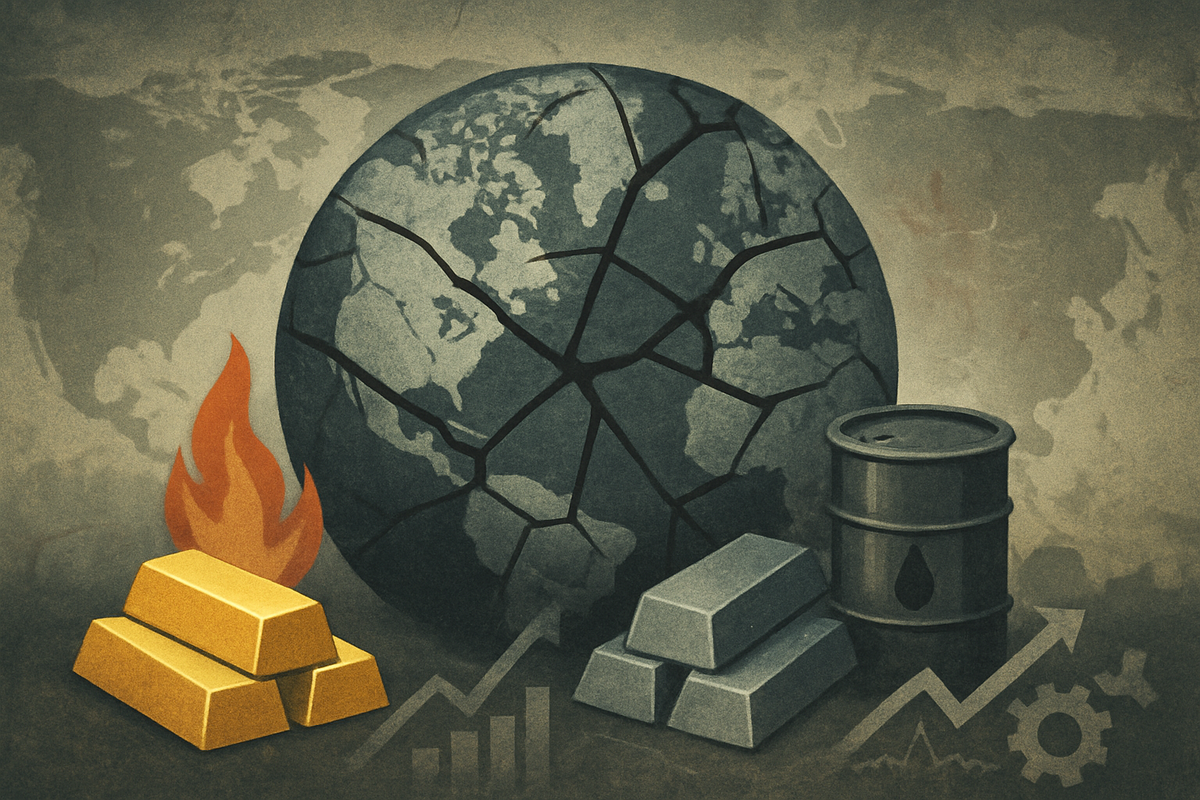Global Commodity Markets Brace for Policy Headwinds and Tariff Escalations in 2026

The global commodity markets are poised for a tumultuous 2026, as a confluence of shifting policy risks, most notably escalating tariffs and persistent geopolitical tensions, threatens to redefine trade flows and investor strategies. Analysts are forecasting a challenging period characterized by continued volatility, a general contraction in aggregate commodity prices, and a significant reorientation of global supply chains as nations grapple with heightened economic nationalism and the lingering effects of previous trade disputes. This complex environment necessitates a cautious yet strategic approach from investors, with an emphasis on diversification and a keen eye on specific commodity performances.
The immediate implications of these policy shifts are far-reaching. While specific tariffs can inflate the cost of targeted imported goods, the broader economic impact tends towards deflationary pressures, driven by reduced consumer confidence and a general slowdown in global demand. This dynamic is expected to contribute to a projected easing of global GDP growth in 2026, particularly affecting investment-heavy sectors like manufacturing and construction, which are major consumers of energy and industrial metals. The resulting uncertainty is already manifesting in increased price volatility across various commodity futures markets, compelling countries and corporations to re-evaluate their sourcing strategies and seek out untaxed or lower-cost alternatives.
A Web of Tariffs and Geopolitical Pressures
The landscape of policy risks for 2026 is dominated by the specter of escalating tariffs and persistent geopolitical instability. The "Trump administration" has already implemented substantial tariffs, ranging from 10% to 50%, on a broad spectrum of imported goods as of August 2025. While critical metals and energy products have largely been spared from blanket tariffs, specific duties are impacting sectors such as ammonia (15% on imports from Trinidad and Tobago), palm oil (19% on Indonesian imports), and certain Indian agri-food products (50%). Steel and aluminum continue to face a significant 50% tax, underscoring a broader trend of trade protectionism.
Looking ahead, the indications point to potential further tariff escalations. There are signals of possible increases in tariffs on pharmaceuticals, potentially reaching as high as 200% by mid-to-late 2026. Broader increases in US tariffs are also anticipated, contributing to what analysts describe as a "soft" global trade environment. The looming 2026 renewal of the USMCA agreement, particularly under a potentially Republican-controlled Congress, presents another significant source of trade policy uncertainty. This overarching trend of economic nationalism, prioritizing domestic industries through measures like tariffs and import quotas, is actively reshaping global trade dynamics and is expected to accelerate geo-economic fragmentation.
Beyond tariffs, ongoing geopolitical tensions, including the Russia-Ukraine war and instability in the Middle East, are expected to maintain a geopolitical risk premium on commodity prices, especially for oil, through 2026. These conflicts introduce significant variables that can trigger sharp price spikes due to fears of supply disruptions. Resource nationalism, particularly concerning rare earth metals, is also emerging as a growing concern, adding another layer of complexity to supply chains. Furthermore, China's economic performance, marked by weak industrial activity and a prolonged crisis in its real estate sector, poses significant downside risks to global demand for oil and base metals, while its ambitious industrial policies, such as the "Made-in-China 2025" initiative, continue to fuel trade tensions. Lastly, the "complications arising from a changing climate" are identified as a top-five economic risk for commodity trading, introducing policy-related uncertainties around critical mineral supply chains even as the clean energy transition drives demand for industrial metals. Initial market reactions to these developments have already seen significant drops in stock indexes and raised concerns about inflation and overall economic growth, highlighting the immediate and profound impact of these policy shifts.
Corporate Fortunes: Winners and Losers in a Protectionist Era
The intensifying policy risks and the specter of escalating tariffs are set to create a distinct divide in corporate fortunes across the global commodity landscape for 2026. Companies with diversified operations, robust domestic capabilities, or those positioned to benefit from safe-haven demand are likely to weather the storm, or even thrive, while those with intricate global supply chains and heavy reliance on unfettered international trade face significant headwinds.
In the energy sector, integrated giants like Exxon Mobil Corporation (NYSE: XOM) and Chevron Corporation (NYSE: CVX), with their diversified global operations and strong domestic production in the U.S., could emerge as relative winners. If geopolitical tensions disrupt supply from less stable regions, leading to higher oil and gas prices, their extensive asset base and logistical capabilities would allow them to capitalize. Conversely, European integrated energy companies such as TotalEnergies SE (NYSE: TTE) and Shell plc (NYSE: SHEL), with substantial investments in potentially unstable regions and reliance on specific trade routes, could face greater exposure to supply chain disruptions and regulatory changes, impacting their profitability and stock performance. Beyond traditional energy, NextEra Energy, Inc. (NYSE: NEE), a leader in renewable energy, stands to benefit from policies promoting energy independence and decarbonization, offering stable revenue streams insulated from fossil fuel price volatility.
The metals sector will also see a clear bifurcation. Gold miners like Barrick Gold Corporation (NYSE: GOLD) and Newmont Corporation (NYSE: NEM) are poised to gain significantly from increased geopolitical instability and economic uncertainty, as gold traditionally serves as a safe-haven asset. Their profitability directly correlates with rising gold prices, making them attractive to investors seeking refuge from broader market risks. Similarly, Freeport-McMoRan Inc. (NYSE: FCX), a U.S.-based major copper producer, could benefit if trade policies or geopolitical tensions restrict copper supply from other regions, driving up domestic prices, especially given the demand from "green economy" initiatives. On the losing side, diversified global mining giants such as Rio Tinto Group (NYSE: RIO) and BHP Group (NYSE: BHP), highly reliant on global trade flows for iron ore, copper, and aluminum, could face substantial challenges. Broad tariffs on industrial metals or disruptions to their extensive supply chains, particularly involving China, could increase logistics costs, reduce market access, and compress their profit margins.
In agriculture, global agribusiness processors and traders like Archer-Daniels-Midland Company (NYSE: ADM) and Bunge Global SA (NYSE: BG) are well-positioned to navigate disruptions. Their diversified sourcing and distribution networks allow for flexibility in re-routing supplies and arbitraging price differences created by regional trade barriers or export restrictions. Fertilizer producers such as Nutrien Ltd. (NYSE: NTR) and CF Industries Holdings, Inc. (NYSE: CF) could also benefit from increased demand for food security and potentially higher fertilizer prices if geopolitical tensions restrict supply from key producing regions. However, large food processors and exporters like Tyson Foods, Inc. (NYSE: TSN) face significant risks from retaliatory tariffs on agricultural products or increased costs for international logistics, which could severely impact their export markets and profitability.
Finally, the manufacturing sector, with its complex global supply chains, is particularly vulnerable. Companies like Caterpillar Inc. (NYSE: CAT), a global manufacturer of heavy equipment, might benefit from a "reshoring" trend in construction and mining within regions less affected by trade wars, especially if domestic infrastructure investments increase. Lockheed Martin Corporation (NYSE: LMT), a leading defense contractor, is a direct beneficiary of heightened geopolitical tensions, as increased defense spending often leads to robust order backlogs. Conversely, highly diversified manufacturers with extensive global footprints such as Honeywell International Inc. (NASDAQ: HON) and major automotive parts suppliers like Magna International Inc. (NYSE: MGA) are highly susceptible to tariffs on components, trade barriers, and any general slowdown in global vehicle production caused by economic uncertainties. These companies could face supply chain disruptions, increased input costs, and reduced demand, significantly eroding their profit margins and stock performance.
Broader Implications: A New Era of Economic Fragmentation
The evolving landscape of policy risks and tariffs in 2026 is not merely a transient market fluctuation but rather a profound shift that is accelerating broader industry trends and reshaping the very fabric of global commerce. These developments are ushering in an era of increased economic fragmentation, demanding strategic recalibrations from businesses and governments alike, while echoing historical precedents of protectionist policies.
At the heart of this wider significance is a trend towards decelerating global growth and deglobalization. The World Trade Organization (WTO) projects a slowdown in world merchandise trade growth, directly attributable to new tariffs and persistent supply-chain disruptions. This aligns with a broader movement away from the hyper-globalization of previous decades, driven by increased geopolitical tensions and a desire for greater national economic sovereignty. Conflicts such as the Russia-Ukraine war and instability in the Middle East continue to exert a geopolitical risk premium on commodity prices, particularly in energy markets, further fragmenting global trade networks and spurring "friendshoring" or "nearshoring" strategies to secure critical supply chains. Simultaneously, the accelerating energy transition remains a paramount driver, fueling an insatiable demand for critical minerals like copper, lithium, and nickel, creating a structural bullish trend for these "transition minerals" even as it potentially curbs long-term oil demand. This complex interplay underscores a growing prioritization of supply chain resilience over lowest-cost sourcing, with businesses actively diversifying strategies (e.g., "China+1") and investing in digital infrastructure to mitigate disruptions.
The ripple effects of these policy shifts are expected to be far-reaching, impacting competitors, partners, and entire national economies. Tariffs, such as the lingering 50% duties on steel and aluminum between the EU and the US, distort global supply chains, introduce structural inefficiencies, and fuel cost pressures. For instance, U.S. tariffs on steel, aluminum, and copper could increase material and service costs for the oil and gas industry by 4% to 40%, potentially compressing margins and delaying investment decisions. Commodity-dependent nations, especially emerging markets, face significant economic challenges as lower commodity prices and trade tensions pressure national budgets. This environment also compels shifts in trade flows, with firms adjusting target markets and diversifying supply chains; European exporters of steel-dependent products, for example, are increasingly diversifying into markets like Mexico, leveraging lower manufacturing costs and USMCA tariff benefits. Furthermore, tariff pressures are prompting a surge in mergers and acquisitions (M&A) activity as companies seek to consolidate supply chains and secure local production assets, particularly in the metals and agri-food sectors. The strength of the U.S. dollar, often influenced by protectionist threats, can also broadly put dollar-denominated commodities under pressure, affecting global purchasing power and capital flows.
Beyond direct tariffs, a broader array of regulatory and policy implications will shape the 2026 landscape. The European Union's Carbon Border Adjustment Mechanism (CBAM) is set to expand in 2026, imposing carbon taxes on imports for industries like steel, cement, and aluminum. This will create significant compliance burdens and redefine competitive landscapes for carbon-intensive commodity producers. The proliferation of other trade regulations, including Environmental, Social, and Governance (ESG) mandates and data privacy laws, is increasing compliance complexities. Non-tariff barriers such as export controls on critical technologies and anti-dumping measures will further complicate cross-border trade, reflecting national security and industrial policy objectives. Moreover, divergent fiscal and monetary policies across major economies raise the risk of policy missteps, fueling pressure on asset prices, currencies, and commodities.
Historically, the impact of significant policy shifts and tariffs on commodity markets has been consistently disruptive. The Smoot-Hawley Tariff Act of 1930, which raised U.S. import duties to nearly 40%, stands as a stark precedent, leading to retaliatory tariffs, a drastic decline in global trade, and contributing to the Great Depression. Commodity prices across industrial metals, agriculture, and energy saw severe and extended declines. More recently, the U.S.-China Trade War (2018-present), characterized by aggressive tariffs, disrupted global supply chains and cost U.S. farmers billions. These historical events consistently demonstrate that while protectionist measures aim to safeguard domestic industries, they often trigger retaliation, disrupt economies, and can have far-reaching, sometimes escalating, consequences. The enduring lesson is that long-term economic stability and growth are best fostered through cooperation and open markets, a lesson that will be acutely tested in 2026.
The Road Ahead: Navigating a Volatile 2026 and Beyond
As global commodity markets brace for the impact of shifting policy risks and tariffs in 2026, stakeholders are confronted with a landscape defined by both formidable challenges and emerging opportunities. The immediate future points to a general contraction in aggregate commodity prices, but beneath this broad trend lies a complex tapestry of divergent sector performances and the urgent need for strategic adaptation.
In the short-term (2026), a prevailing bearish sentiment suggests a potential fourth consecutive year of decline for global commodity prices, possibly reaching a six-year low. This downturn is largely attributed to a global economic slowdown, persistent trade tensions, and ample supply in several key markets. However, this overall decline masks significant divergences. Precious metals, particularly gold and silver, are expected to remain relative outperformers, benefiting from their safe-haven appeal amidst economic uncertainty and sustained central bank demand. US natural gas is also projected to see gains, supported by higher LNG exports. Conversely, energy prices, especially oil, are anticipated to fall due to slower demand growth (particularly from China), a growing surplus, and increased OPEC+ supply capacity. Industrial metals are likely to face continued pressure from weak industrial demand and the lingering effects of tariffs, which are also expected to contribute to lower U.S. real GDP growth and increased consumer prices for affected goods.
Looking at the long-term (beyond 2026), the current period of weak prices could ironically deter future investment in commodity projects, potentially leading to supply shortages and higher prices in subsequent years. Some analyses suggest that aggregate commodity prices could stabilize by mid-2026 and begin a gradual recovery into 2027 as global economic activity improves. Crucially, the ongoing push for energy transition is unlikely to abate, creating sustained demand for critical minerals like copper and nickel, which could present long-term opportunities despite short-term challenges for industrial metals.
To navigate this volatile environment, businesses must prioritize supply chain resilience and diversification, moving towards "near-shoring" and "friend-shoring" strategies to mitigate geopolitical disruptions. Enhanced risk management and hedging, including dynamic scenario testing and the use of financial instruments like forward contracts, will be crucial. Investing in technological innovation to reduce material intensity and diversifying trading portfolios into new commodity classes (e.g., electricity, battery metals) will also be essential. Furthermore, aligning with Environmental, Social, and Governance (ESG) standards will become increasingly important due to climate change pressures and carbon border adjustment mechanisms (CBAMs). Governments, in turn, should focus on fostering diverse domestic production, particularly for critical minerals, and consider strategic reserves to enhance security of supply. Fiscal prudence during periods of easing commodity prices and careful navigation of trade and fiscal policies, such as the EU's expanding CBAM, will be paramount.
Emerging markets face both significant challenges and nascent opportunities. While many emerging economies are projected to experience slower GDP growth due to the spillover effects of U.S. tariff increases, weaker capital inflows, and lower commodity prices, opportunities can arise in sectors that benefit from lower input costs. The persistent demand for critical minerals and technologies related to the energy transition will also create investment opportunities in battery technology, electric vehicle infrastructure, and renewable energy projects. Emerging markets in Asia and Africa, such as India, Vietnam, and Nigeria, are expected to play larger roles in global trade, driven by growing consumer markets and strategic trade policies.
Several potential scenarios loom for global commodity markets in 2026. A base case predicts a moderated decline in aggregate commodity prices through 2026, followed by stabilization and gradual recovery, assuming a global economic slowdown that avoids a severe recession and a gradual unwinding of trade tensions. An upside scenario could see an escalation of geopolitical tensions, particularly in the Middle East or related to the Russia-Ukraine conflict, leading to significant supply shocks and sharper price spikes across various markets. Conversely, a downside scenario envisions a more severe or prolonged global economic slowdown, exacerbated by escalating trade wars and increased policy uncertainty, leading to a deeper and more precipitous drop in commodity prices and amplifying global economic instability. Strategic foresight, supply chain agility, and diversification will be paramount for all stakeholders to navigate this "new normal" and identify opportunities within the challenging environment.
Conclusion: Navigating the New Normal of Commodity Markets
The global commodity markets are embarking on a period of profound transformation, with 2026 serving as a critical juncture defined by persistent policy risks and the pervasive influence of tariffs. This intricate web of geopolitical tensions, evolving trade policies, and a projected slowdown in global economic growth is fundamentally reshaping the landscape for energy, metals, and agricultural sectors, demanding a sophisticated and adaptive approach from all market participants. The World Trade Organization's (WTO) downgraded 2026 global trade growth forecast to a mere 0.5% underscores the formidable headwinds confronting international commerce as the long-term effects of U.S. tariffs become increasingly pronounced.
Key Takeaways
The overarching narrative for 2026 points to an overall decline in global commodity prices, with projections indicating nearly a 10% drop through the year, marking the fourth consecutive year of moderation. This is largely driven by an anticipated oil surplus and improving supply conditions. However, this price moderation runs parallel to a significant deceleration in global trade, heavily influenced by tariff uncertainty that continues to weigh on business confidence, investment, and supply chains. Geopolitics has undeniably emerged as a primary driver, often superseding traditional supply-demand dynamics. A fragmented global landscape, characterized by distinct U.S. and China spheres of influence, is increasingly utilizing agricultural commodities as "pawns on a geopolitical chessboard" and driving policy decisions in industrial metals and energy.
Despite the aggregate bearish outlook, a divergent commodity performance is expected. While energy prices, particularly oil, are projected to continue their decline due to an oversupplied market and softer global demand (especially from China), precious metals like gold and silver, along with natural gas, are anticipated to be relative outperformers, benefiting from their safe-haven appeal amidst economic and geopolitical uncertainties. In industrial metals, despite near-term headwinds from weak industrial demand and tariff impacts, the long-term demand fueled by the energy transition continues to present opportunities in critical minerals such as copper, aluminum, and rare earths. Resource nationalism, particularly in battery metals like cobalt, will restrict supply and drive prices higher, with the EU's Carbon Border Adjustment Mechanism (CBAM) also set to influence European aluminum premiums from 2026. Agricultural prices are expected to soften through 2026, supported by robust production and favorable stock levels, though trade disruptions and fluctuating regional prices remain key concerns. Crucially, the persistent threat and implementation of tariffs are accelerating supply chain restructuring, leading to strategies like near-shoring and friend-shoring to enhance resilience and diversify sourcing.
Assessment of the Market Moving Forward
The global commodity market in 2026 will be characterized by sustained volatility and increased fragmentation. The anticipated easing of global GDP growth, influenced by tariffs and the fading effects of demand front-loading, will subdue overall commodity demand, particularly in investment-heavy sectors. While falling energy and food prices are expected to contribute to easing global inflation, tariff-related costs could keep inflation sticky in some regions, notably the U.S. Looking beyond 2026, there is a potential for supply-side risks to emerge. Reduced investment in mining and energy sectors during 2024-2025 could tighten future supply, setting the stage for sharper price upswings in the years following 2026. The increasing role of Artificial Intelligence (AI) in driving investment and productivity gains is also a developing factor, potentially influencing demand for power and resources, though its immediate impact on overall commodity demand remains to be fully seen.
Final Thoughts on Significance and Lasting Impact
The trends observed for 2026 represent more than just cyclical fluctuations; they signify a fundamental macroeconomic rebalancing with lasting implications for global industries and policy frameworks. The "middle game" of geopolitical restructuring means that political decisions will continue to significantly shape trade dynamics, potentially more so than traditional market forces. This environment presents a critical opportunity for policymakers. Lower energy prices, for instance, could enable governments to phase out costly fuel subsidies and redirect resources towards infrastructure or renewable energy initiatives, aligning with broader climate goals. However, it also poses a dilemma, as cheaper fossil fuels could reduce the immediate economic incentive for decarbonization. Ultimately, the emphasis on supply chain resilience and diversification is likely to be a permanent shift, reshaping global trade architecture for years to come.
What Investors Should Watch For in Coming Months
Investors navigating the complex commodity landscape of 2026 should focus on several key areas:
- Geopolitical Developments: Closely monitor major geopolitical tensions, particularly U.S.-China trade relations, ongoing conflicts in Eastern Europe and the Middle East, and resource nationalism policies globally. These will continue to be significant drivers of market uncertainty and price volatility.
- Trade Policy Evolution: Pay close attention to the implementation and potential escalation of tariffs, including existing U.S. Section 232 tariffs on steel and aluminum, potential new tariffs (e.g., on pharmaceuticals), and the broadening scope of the EU's CBAM. Also, monitor any U.S. reviews of tariffs on non-domestically produced goods.
- Global Economic Indicators: Track global GDP growth forecasts, industrial production data (especially from China), and regional inflation rates, as these will directly impact commodity demand.
- Central Bank Monetary Policy: Keep a close eye on interest rate decisions and forward guidance from major central banks, particularly the U.S. Federal Reserve, as these influence currency strength and dollar-denominated commodity prices.
- Sector-Specific Opportunities:
- Precious Metals: Gold and silver are expected to remain strong due to safe-haven demand and central bank buying, making them attractive diversifiers.
- Natural Gas: Anticipated to continue outperforming.
- Strategic Metals: Despite near-term pressures, the long-term demand for metals crucial to the energy transition (e.g., copper, aluminum, nickel, rare earths) presents structural growth opportunities.
- Agriculture: Some analysts view agriculture as a compelling entry point following recent underperformance, with careful consideration of specific crops and regions.
- Supply Chain Resilience and Diversification: Favor companies demonstrating robust supply chain resilience, actively diversifying sourcing, and engaging in near-shoring or friend-shoring strategies.
In essence, 2026 demands a highly adaptive and informed investment strategy, recognizing that political decisions and evolving trade landscapes will be as impactful as traditional market fundamentals.
This content is intended for informational purposes only and is not financial advice
More News
View More




Recent Quotes
View More
Quotes delayed at least 20 minutes.
By accessing this page, you agree to the Privacy Policy and Terms Of Service.